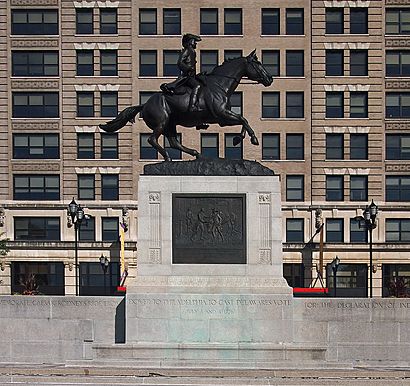Equestrian statue of Caesar Rodney facts for kids
Quick facts for kids Statue of Caesar Rodney |
|
|---|---|

The statue in 2016
|
|
| Artist | James E. Kelly |
| Year | 1923 |
| Subject | Caesar Rodney |
| Location | Wilmington, Delaware, U.S. |
| 39°44′45″N 75°32′50″W / 39.74595°N 75.54730°W | |
A statue of Caesar Rodney used to stand in Wilmington, Delaware, United States. It was put up in Rodney Square in downtown Wilmington on July 4, 1923. A sculptor from New York named James Edward Kelly designed it. The Gorham Company in Rhode Island made the statue and its two bronze plaques. The memorial was taken down in June 2020. We don't know exactly where it is now or when it will be shown again. Its removal caused some discussion.
Contents
The Caesar Rodney Statue: A Look at Its History
What the Statue Looks Like
The statue had special bronze plaques on its base. One plaque showed Thomas McKean meeting Rodney in Philadelphia. The other plaque showed Rodney casting a very important vote. This vote helped decide that America would become independent.
On top of the base, Rodney was riding his horse. The horse looked like it was galloping very fast. Its front feet were in the air. Most of the statue's weight rested on the horse's back legs. To make sure the statue stood up straight, the artist made the horse's tail heavy. He also placed Rodney upright and towards the back of the horse.
Why Was This Statue Made?
Money for the statue was collected by a special group. This group was called the Caesar Rodney Equestrian Statue Executive Committee. They wanted to remember Rodney's famous ride. He rode from Kent County, Delaware all the way to Independence Hall in Philadelphia. This important ride happened on July 1 and 2, 1776.
Why Was It Moved?
The statue was taken away from public view on June 12, 2020. Another statue, the statue of Christopher Columbus, was also moved in Wilmington, Delaware. This happened after many people protested following the death of George Floyd. The statues were moved to keep them safe.
Images for kids



